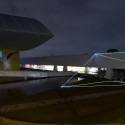
The term light of world, triggers several points of discussion and reflection. The most obvious of definition is offered by the chief curator, Teixeira Coelho, who had previously worked in the 2013 edition of this Biennial. But let us first approach the theme by its opposite, darkness. Darkness is a precondition for the existence of light – it irradiates when darkness exists. Light, as much as water and air, is essential to human existence, and to a certain degree, it is its contrast with darkness that, allows us to interpret this exhibition. The contrast between light and darkness reflects the many aspects of the access to the several spaces of the Biennial.
Several spaces, several curators, several circuits. The sensation that an optical network of the Biennial axes spreads out in the city of Curitiba is evident – irradiation in every sense of the word. Beauty, as an inseparable attribute of light, refers to the allegorical Baroque period, and this is bolstered by the reference to the 1927 novel by the Icelandic author Halldór Laxness. Teixeira Coelho brings up the book for the manner, in which the author states that the power of beauty is the core of the aesthetics experience.
Part of the Biennial’s main works is displayed in two rooms of the Municipal Museum of Art -Muma. Three works are displayed on one of the walls: two small Italian baroque paintings – by Ciro Ferri and Agostino Masucci – stand aside a work made with spatula and thick brush strokes, which in turn is placed between two other contemporary paintings by the Brazilian artist Adriana Varejão. The thematic is the same: divine light and religious, catholic faith. The wall brings together different times and this anachronism is very welcome in a contemporary exhibition. 
It is such a pleasant surprise, the same goes for encountering the installation of Bill Viola. Up the spiral staircase of one of the towers of the Metropolitan Cathedral of Curitiba, which gives access to the mezzanine where an impressive church organ awaits, we come across the artist’s video work. Like a spiritual portal, the video, which inspired in sacred scriptures, takes us to three women portrayed on camera in a slow mesmerizing atmosphere.
Looking from another perspective, in Oscar Niemeyer Museum – MON – Dan Flavin and Julio Le Parc are examples of memorable attractions and record attendance. Visitors standing in lines to see the works displayed at the MON is a routine in this Biennial. Would this be because of the wonder of letting ourselves be involved by the space tissues and pulsating light of Le Parc? Probably so. Light, as a chemical-physical phenomenon, that stems from the combination of multiple colours is in itself, stunning. Just look at rainbows.
Technology also creates the interaction between art and the public, but not only that. It also has the power of bringing human beings closer to the experience of art through dialogues on religion, magic, beauty, technology, architecture and wonder. The white concrete walls of the newly remodelled Train Station of Curitiba are changed by the colourful curves of Tom14. There are no artificial lights, nor technology tricks, but rather, many colours and sensuous curves that catch the eye of the passers-by.
Divided into Circuits, Main Exhibition and Open Biennial, this edition of the International Biennial of Curitiba unfolds, reinvents and multiplies itself. It awards prizes to young curators, launches public notices and selects college students to participate in a circuit of their own, opening possibilities of institutional visibility. In times of economic turmoil, it promotes a circuit of city museums, favouring spaces that are sometimes forgotten, attracting visitors not only to the many galleries existing in the city. This is why visiting the show to see the artist’s line up and spaces that dialogue with art, is worthwhile.
It should be mentioned that UNESCO declared 2015 as the Year of Light. The theme may strike as a cliché, but under the curatorship of Teixeira Coelho, it becomes an endless network of entangled meanings represented by the number of participating artists and guest curators. The event spreads throughout the city, reinforcing the vastness of the Biennial’s discussion and the effectiveness of its approach. The title of this edition expresses a desire to seek the Light of the World. We must not forget, though, that the search is just beginning. Light, albeit important, is not the end point of arrival of the art experience. Beauty is the greatest goal of its journey.
Curitiba Biennial 2015
through december 6
Several locations
bienaldecuritiba.com.br

Deixe um comentário